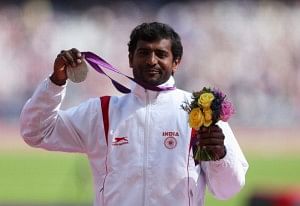
Hail the Paralympic heroes!

Ever heard of David Roberts? Oscar Pistorius? Let’s try again. Ever heard of Michael Phelps? Usain Bolt? Most probably, yes. After all, they are the two most celebrated athletes of the present generation. And now, let’s try to find out the identities of the first two persons in relation to the latter two. David Roberts is the Paralympion counterpart of Michael Phelps and Oscar Pistorius of Usain Bolt. David Roberts has won 11 Paralympics gold and Pistorius has won 6 gold medals in the summer Paralympics. This discrepancy probably shows in a nutshell, how differently the world at large views these two sporting events, although they share the same host city and the same facilities on every occasion.
Paralympics has come a long way from 1948 when it was organized for World War II veterans with spinal cord injuries, to 2012 when 165 countries and 4200 athletes took part in it. But it still has a long way to go for it to fulfil its mission of “To enable paralympic athletes to achieve sporting excellence and inspire and excite the world”. The athletes are achieving excellence; they are inspiring and exciting but, is the world inspired and excited? This is evident in the lack of media coverage of the Paralympics. This is in stark relief to the widespread media coverage received by the Olympics. But it’s unfair to blame only the media. The sports entertainment channels’ clear priorities are ratings and viewership numbers, so the Paralympics not receiving enough media coverage is just the symptom, not the cause. The root cause may lie in the disinterest of governments towards the event, a general lack of awareness and to some extent, a lack of sensitivity. The most prominent example of this is the US government. The US Olympics Committee has been criticized quite a few times for their discriminatory attitude, in terms of funding and benefits, towards paralympion athletes. This is also reflected in their rankings in the two events. While the US is the undisputed leader in the Olympics, US ranks just sixth in the Paralympics medal tally.

For India, HN Girisha’s incredible feat of winning the Silver in the F42 high jump for men, would have almost gone unnoticed, if not for the facebooking and Twitter community of India. And even then, the recognition and celebrations are nowhere near as widespread and jubilant as befitting a country with a billion plus population. After his win, three cash rewards of a combined value of Rs. 45 lakhs were awarded for him. Compare that with the rewards announced for the Indian Cricket World Cup winning team, each member was awarded with Rs. 1 crore. While Indian able bodied athletes are supported by government jobs, Girisha was struggling to get a job, until recently. The 2012 Paralympics controversy over lack of escorts for athletes seemed like adding salt to injury. Another example would be Devendra Jhajharia. While Rajyavardhan Rathore was feted for his silver medal at the 2004 Olympics by the media and nation, Jhajharia’s gold medal at the Paralympics 2004 hardly received any attention.
But amidst this gloom, there’s still a silver lining, a ray of hope. The social networking committee of India hailed HN Girisha’s feat, facebook was flooded with congratulatory messages for Girisha, and he received a warm welcome on his return. For all its shortcomings and negative effects, social networking has increased awareness about many social issues. In the world of daily updates and status messages, every issue and every achievement gets its due attention. While not a solution to the plight of paramlympions, social networking sites are a good step in the right direction. The buzz generated by such sites can lead to instant recognition and prompt actions from the media, and government. But will this short term recognition and actions lead to sustainable development of the paralympic sport? Probably not, not when there’s always a new issue and a new hero for the highly fickle social junta to focus on.
While it’s not possible to change the world, we, as Indians should try to improve the situation for Paralympions in India. The onus, for that, lies on the Indian government. It needs to take stern actions and give the Paralympic committe of India a hard push in the right direction. The PCI should take definitive steps to improve facilities and training opportunities for the athletes. It should be made sure that adequate coverage is given to the Paralympics, at least by the national news channels. While Doordarshan covered the Olympics extensively, its coverage of Paralympics was hardly adequate. Improved coverage of the Paralympics would bring awareness, and more recognition for these athletes, and in general, would help us to integrate differently abled people in to our society. These athletes are an inspiration, not only for the differently abled population of India, but also for us, for their sheer strength and determination. It’s time to give them their due and hail our new heroes.